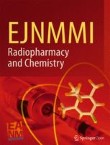Topical Collections about latest and interesting topics in EJNMMI Radiopharmacy and Chemistry are available at: https://link.springer.com/journal/41824/collections
Generic semi-automated radiofluorination strategy for single domain antibodies: [18F]FB-labelled single domain antibodies for PET imaging of fibroblast activation protein-α or folate receptor-α overexpression in cancer
Radiofluorination of single domain antibodies (sdAbs) via N-succinimidyl-4-[18F]fluorobenzoate ([18F]SFB) has shown to be a promising strategy in the development of sdAb-based PET tracers. While automation of the...

